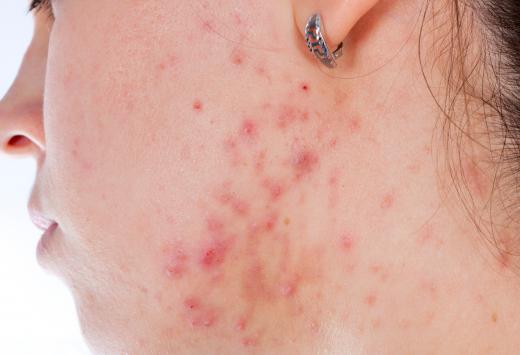At BeautyAnswered, we're committed to delivering accurate, trustworthy information. Our expert-authored content is rigorously fact-checked and sourced from credible authorities. Discover how we uphold the highest standards in providing you with reliable knowledge.
How Effective is Photodynamic Therapy for Acne?
Photodynamic therapy for acne involves using a particular wavelength of light in conjunction with a light-sensitive medicine to try to clear the skin. It often works for patients with treatment-resistant acne, but it is impossible to say with any degree of certainty just how effective it is or to predict the likelihood that photodynamic therapy for acne will work for any particular patient. Various skin conditions improve dramatically in some patients and not in others. Conditions most likely to improve from the treatment include acne vulgaris, sun damage and actinic keratosis.
Photodynamic therapy for acne came about as a result of photodynamic therapy to treat some cancerous and precancerous cells. In the course of the cancer treatment, doctors noticed an improvement in other skin conditions, and the treatment made its way into the cosmetic arena. Scientific studies, however, have been inconclusive about the treatment's effectiveness for acne. Some study results have shown as much as 81 percent improvement in the condition being treated, while others have shown so little improvement as to be statistically irrelevant. Websites that offer patient reviews of the treatment show similarly mixed results, with some swearing by it and others saying they saw little to no improvement.

During a photodynamic therapy session to treat acne, a photosensitizing agent — usually aminolevulinic acid — is applied to the skin. This is followed by an incubation period ranging from minutes to days. The skin is then exposed to light of various wavelengths. The light activates the photosensitizing medication, which results in the creation of excited oxygen molecules that destroy nearby cells.

Another form of photodynamic therapy for acne uses methyl aminolevulinate to sensitize skin. No significant difference in effectiveness has been observed between the two types of treatments. Possible side effects of photodynamic dynamic therapy for acne include pain during illumination, redness, exfoliation, crusting and pustular eruptions. The exfoliation helps clear away dead skin cells and dirt. A fan can be used to help cool skin during the treatment.

Advantages of photodynamic therapy for acne include rapid treatment and the absence of surgical excisions. While oral acne medications often have systemic effects, photodynamic therapy for acne is topical and, thus, has no systemic side effects. The resulting exfoliation can also leave skin looking younger. Treated skin will be red and peeling for several days after the treatment, and a patient must remain indoors the day after the procedure to avoid sun exposure. As an extra precaution, the application of sun screen is recommended.
Photodynamic therapy for acne treatment usually requires a series of treatments to be fully effective. These treatments typically happen from two to four weeks apart. To retain a rejuvenated appearance, additional treatments can be performed periodically. To maximize the effectiveness of photodynamic therapy for acne, the physician should tailor the treatment to the individual patient's skin and the body part being treated. While facial skin only needs a short incubation period with photosensitizing agents, the skin of the chest, back and forearms requires a longer incubation period.
AS FEATURED ON:
AS FEATURED ON:













Discuss this Article
Post your comments